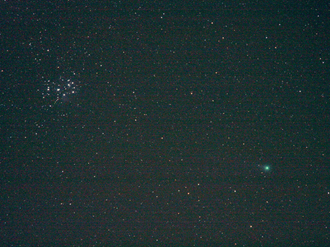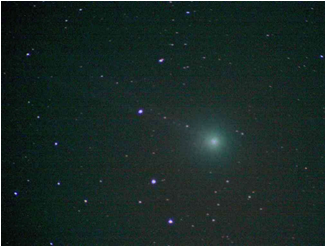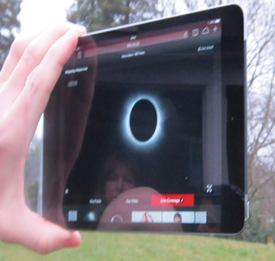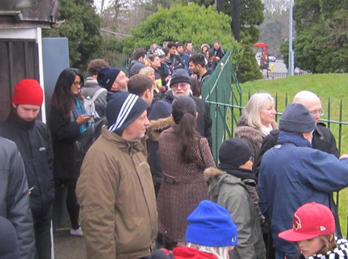H.S.S. ASTRONOMY SECTION REPORT 2014 - 2015 SESSION
Doug Daniels (Joint Astronomy Secretary)
Comet Lovejoy (2014 Q2)
Discovered by Terry Lovejoy in Australia on August 16th and is currently travelling northwards. By early January 2015, the comet will be moving upwards, passing 10 degrees or so west of Rigel on Jan. 6th and then west of the Pleiades on Jan. 20th. At its brightest around Jan. 10th, Lovejoy should attain about Mag. 4.2. It will appear as a large diffuse Coma with a brighter centre condensation with perhaps a short tail. On the evening of January 10, the Astro Sec. (Doug) found it using 7x50 binoculars at 21:15 hrs. It appeared as a small dim circular patch with a not very bright condensation and no evidence of a tail. It did not appear to be much brighter than about Mag.6 so it does not appear to have brightened to the predicted value
Observing from the darker skies of Weston Coleville (Cambs.), but still with a moon in the sky, Terry Pearce managed to get images of Lovejoy on January 6th at 20:30 hrs. He described it as a pale disk with a distinct greenish hue resembling an out of focus globular cluster.
Venus/Mercury Conjunction & Comet Lovejoy.
On the evening of January 14th, Venus and Mercury were in conjunction in the low south-western sky after sunset. Simon took his portable telescope into the road at Hampstead but a low cloud bank prevented observation.
The Astro Sec. (Doug) had better luck on the following evening. A very clear sky just after sunset presented a clear view of the conjunction, with Venus and Mercury in the same binocular field of view. Simon also had better luck on the 15th, as did Kevin McNulty and John Culshaw, who watched the event from Parliament Hill and later got a view of Comet Lovejoy.
On Sunday Jan. 18th, Terry Pearce, observing from Weston Colville took 2 images of Lovejoy as it passed close to the Pleiades. The one using a 4-inch lens at f/6, managed to show a double tail.
 |
 |
Comet Lovejoy. Jan. 18 2015 T. Pearce 4-inch f/6 lens 30 secs. Canon 100D DSLR
On the 24th- 25th of January, it was possible to view all the major planets, provided that you had the stamina! Mercury & Venus were visible at sunset, followed by Mars, Neptune and Uranus. Jupiter was visible for most of the night and Saturn was rising low down in Scorpio before dawn. There was also a 4 day old crescent Moon to add to the occasion and Comet Lovejoy was passing close to beta Arietis. The evening turned out to be particularly clear resulting in a deluge of visitors to the Observatory, some 100 plus visitors turned up to see some of these wonders and kept Doug, Jim Brightwell and John Tennant busy until well after closing time.
The problem with such large crowds is that it severely limits the number of objects that can be shown. All we could show them was the Moon until it set then M42 Orionis and finally Jupiter exhibiting all 4 moons. Although they had to queue for a long time in the freezing night, they all seemed to enjoy the experience evidenced by the very positive comments and £70+ donations to the fund box.
Total Solar Eclipse March 20th.
On March 20 2015, there was a total Solar Eclipse – 87% partial from Hampstead. The Eclipse began at 8:25 am and ended at 10:41.am. Mid eclipse was at 9:31 am, when 87% of the Sun was obscured. Unfortunately for us the entire event was obscured by relentless cloud. The BBC made the eclipse the main feature of Stargazing Live so public interest was high and despite the early time about 100 visitors turned up at the observatory but their only view of the eclipse was from many ipads and tablets. But all was not lost as Julia managed to recruit three possible assistants.
 |
 |
| What we missed – totality from aircraft | Crowds gather in vain at the Observatory |
|---|
And as I confidently predicted at mid day the Sun came bursting through the cloud cover heralding a nice spring-like afternoon – typical!
But not all our members missed the main event. Kevin McNulty took to the ocean waves north of the Faroe isles on the good ship ‘Boudicca’ together with Paul Abel, Pete Lawrence and Jon Culshaw, They saw the total eclipse in its entirety and Kevin produced a report.
Member’s observing session
Kevin McNulty organized a member’s observing session on April 14th. The weather forecast indicated good observing conditions and with both Venus and Jupiter well placed for observation, it was decided to ‘go for it’. Kevin, Simon, Paul Abel, Jon Culshaw and Martin Fahey came along.
Paul Abel produced a series of excellent drawings of Venus, using various filters and later some nice views of Jupiter showing a transit of Ganymede.
Having tasted success on the 14th, Kevin organized another member’s observing session on April 21st. Quite a few members turned up to view Venus, close to a crescent Moon and Jupiter. However, the seeing conditions were not as good as on the 14th, numerous aircraft contrails caused a thin haze across the western sky.
Observatory Notice Board
During April, Alexander Menegas proposed the construction of an illuminated notice board. The idea was to construct a weather proof notice board that could be attached to the outside observatory wall. It could be a removeable board or it could be made as a fixture. The contents could be varied to provide information on the moon and planets and updated frequently. Alexander (aged 14) wanted to construct and finance the board himself and by the beginning of May, the work was almost complete. Simon fitted an external plug point to power the red light source which would also be useful to power portable instruments. Well done Alexander we like to see our younger members getting involved in this way.
End of Session
The current session of public open nights ended on 10th of May. Because the sky was still light at 8:00 pm, we opened from 9 pm - 11 pm. The 9th was partially clear for a last look at Venus, bright in the western sky, and Jupiter still well placed for observation.
Although the weather was not particularly favourable during the ‘open season’, we still managed to attract close to 1000 visitors during the session, indicating that the Observatory remains as popular as ever. Thanks to all Demonstrators and Assistants for their continued support and thanks to Julia for taking care of the duty roster and looking after the section’s finances. Also many thanks to Kevin for keeping the FaceBook link interesting and lively.
Doug Daniels (Joint Astro. Sec.)
![[Hampstead
Scientific Society]](../../images/hss_logo_metallic.gif)